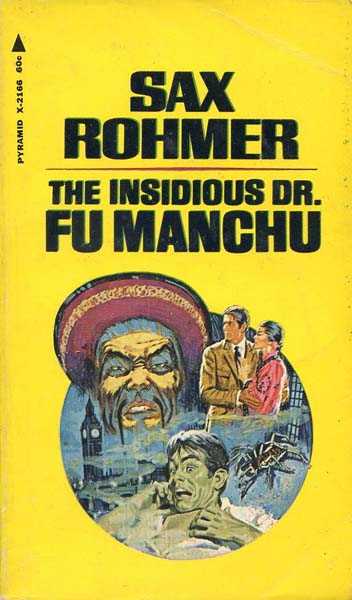 I finished reading The Insidious Dr. Fu Manchu today – just over 100 years since it was published in 1913. I have been trying (for no reason other than pure whim) to bulk out my collection of detective/science fiction pulp novels. This includes focusing on 1900 -1940 paperbacks and such. Naturally, some items are of higher quality than others. However, among the most famous are the Fu Manchu novels of Sax Rohmer (the penname of Arthur Henry Ward 1883 – 1959).
I finished reading The Insidious Dr. Fu Manchu today – just over 100 years since it was published in 1913. I have been trying (for no reason other than pure whim) to bulk out my collection of detective/science fiction pulp novels. This includes focusing on 1900 -1940 paperbacks and such. Naturally, some items are of higher quality than others. However, among the most famous are the Fu Manchu novels of Sax Rohmer (the penname of Arthur Henry Ward 1883 – 1959).
The first thing to discuss is the overwhelming xenophobia present in the novel. There is no ignoring it. I do not care to dwell on it too much. I mean, this is hardly an isolated incident in history. Yellow Peril / Yellow Terror is a pretty common fear theme in the early 1900s especially. Historians can connect this sort of mindset with the events of the world wars and with the sociological milieu of Europe. However, this is a novel review – not a discussion on history and racism.
I read the 1965 Pyramid edition of the novel. I have the first three in the Fu Manchu series in these Pyramid printings. Fu Manchu – or some concept thereof – is rather pervasive in our contemporary society. However, I’d wager most people have neither read the novels or seen the movies. In fact, I am not so sure they know such things exist. After all, I suspect many people think it is just a cool name for facial hair. Or, perhaps, a slightly off-color nickname for a Chinese person. In any case, I doubt people connect the term “Fu Manchu” with this novel.
I have to say that I am not giving the novel a high rating – but not because it contains xenophobia. And not because it seems dated or whatever else. Frankly, the two star rating I am giving it is because it is not very likeable. Simply put.
The two main characters are hideous. I mean, they are just ridiculous and hideous. Nayland Smith and Dr. Petrie are obvious imitations of Sherlock and Watson. But not good imitations. I mean, these two suck. Sherlock and Watson are swift, agile, witty, sharp, clever… whereas Smith and Petrie are pathetic and fail constantly. Rohmer gives Smith some “idiosyncrasies” like tugging on his earlobe and pacing whenever he is stressed. Smith also smokes a pipe (albeit rather unsuccessfully). Petrie is also the one who is narrating the story; but he tells us a repetitive story, reiterating constantly some main points. For example, Fu Manchu is uncanny, the girl-slave is beyond meta supra-beautiful, etc.
The first few chapters are actually kind of difficult to figure out. I was somewhat lost in them – mainly because I felt they were just not well written. Eventually, though, the storyline evens out a bit and makes more sense. Then the reader just follows along as again and again our Smith and Dr. Petrie fail at everything. They are pathetic.
Good things: Rohmer’s descriptions of the opium dens are creepy and intense. I think Rohmer probably went to some such places for “research.” This is important to note because whenever else in reading (Cp. Metropolis, etc.) I come across depictions of opium dens, it is Rohmer’s description that I imagine. If you are interested in this underworld of drugs, you may be interested in these sections. Also: Rohmer does a good job of making sure the reader is scared and disgusted by the villain. He gives us enough to let us know Fu Manchu is a very intelligent, scary villain – but without developing a familiarity that would take the mystery away.
Overall, there is no sense in reading this for a great detective/mystery. This is truly a piece of its time and it shows. I’m glad I read it – I can now discourse on Fu Manchu and find Fu Manchu spin-offs and copycat derivatives in all sorts of media.
2 stars